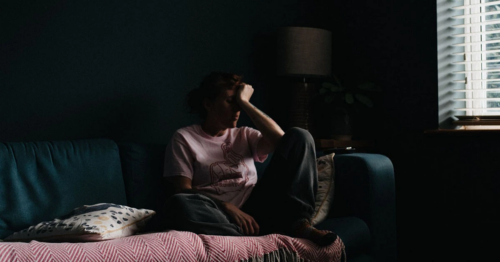
Table of Contents
What Is the Best Therapy for Bipolar Disorder?

Written By: Ashley Laderer

Clinically Reviewed By: Dr. Don Gasparini
January 18, 2024
6 min.
Bipolar disorder can seriously affect functioning and quality of life, but it is treatable. Learn more about treatment options, including the best therapy for bipolar disorder.
Learn more about our Clinical Review Process
Table of Contents
Living with bipolar disorder, sometimes called bipolar depression, can significantly impact one’s ability to function and overall quality of life. “During bipolar mood episodes, it can be difficult to carry out day-to-day tasks, go to work or school, or even just maintain relationships,” says Charlie Health Clinical Director Shawnna Punteney, MS, LPC, NCC, referring to manic episodes and depressive episodes that typically define bipolar disorder symptoms.
However, for the nearly 3% of both teens and adults in the United States living with bipolar disorder, treatment is available. Therapy is often the first step for managing depressive episodes, mania, and mood swings, giving people with bipolar disorder a chance to improve emotional stability, learn coping tools, and more.
Here’s what you need to know about bipolar disorder treatment, including the best therapy for bipolar disorder and the role medication plays in bipolar symptom management.

Take control of your bipolar disorder symptoms
We offer virtual, intensive treatment without a waitlist.
The best therapy for bipolar disorder
In the treatment of bipolar disorder, therapy is a helpful method for managing depression and mania. When you’re in the throes of a hypomanic episode, manic episode, or depressive episode, you may experience unhelpful, distorted thoughts or engage in unhealthy behaviors—therapy is a tool for managing these thoughts and behaviors.
The best therapy for bipolar disorder, though, varies from person to person. Bipolar disorder is a broad mood disorder diagnosis encompassing bipolar I, bipolar II, cyclothymic disorder, and bipolar disorder, other specified or unspecified. An individual’s diagnosis, symptoms, and therapy experience inform treatment. However, here’s an overview of five commonly used therapy modalities for bipolar disorder.
1) Cognitive-behavioral therapy
Cognitive-behavioral therapy (CBT) is a popular type of talk therapy used to treat many mental health conditions, and bipolar disorder is no exception. “CBT allows people to look at how their thoughts, feelings, and behaviors influence each other and how to change those unhealthy thought patterns,” says Punteney. “We call these altered thought patterns cognitive distortions or thinking errors.”
A CBT therapist will help you identify your cognitive distortions so you can understand what types of thoughts are unhealthy and unhelpful. For example, you might discuss what types of thoughts you normally have when you’re in a manic episode or a depressive episode. Next, you will learn to challenge these thoughts and engage in healthier thinking. Healthier thinking will help fuel healthier behaviors. Plus, Punteney says CBT can help you identify your triggers, develop coping strategies, and strengthen emotional regulation skills.
2) Dialectical behavior therapy
Dialectical behavior therapy (DBT) is a form of skill-based therapy that can be very helpful for individuals with bipolar disorder, Punteney says. It typically involves both individual and group sessions. This therapy will help you learn to manage your difficult emotions, whether those emotions are associated with your highs or lows, and improve your relationships.
The four pillars of DBT (and how they relate to bipolar disorder) are as follows:
- Mindfulness skills that help you observe thoughts and feelings without judgment and stay calm and self-aware during mood shifts.
- Distress tolerance skills to cope with intense emotional highs and lows rather than giving into unhealthy coping mechanisms or dangerous impulsive actions.
- Interpersonal effectiveness skills to help you build healthier relationships, communicate healthily, set boundaries, ask for help, and more.
- Emotional regulation skills to cope with intense emotions associated with mania, depression, or mood swings.
3) Group psychoeducation
It can be very helpful for people with bipolar disorder to take part in group psychoeducation so they can learn more about the disorder itself and connect with other people who share the same diagnosis, Punteney says.
Facilitators of the group will educate you (and sometimes your loved ones, as well) on what bipolar disorder is, what causes it, and what the symptoms are. You’ll learn about triggers and early warning signs that a mood episode, either manic or depressive, is coming on. The group might also touch on the differences between bipolar I, bipolar II, and more.
You’ll also learn about bipolar disorder treatment options, including medications and different types of therapy for bipolar disorder. Facilitators may also teach you problem-solving skills, stress-management tools, coping skills, and more.
On top of gaining all this super useful knowledge, group participants openly discuss their experiences, struggles, and wins with peers who also grapple with bipolar disorder. This shared understanding can help alleviate the sense of isolation that people with bipolar disorder commonly experience.

4) Family-focused therapy
Family-focused therapy includes a combination of bipolar disorder psychoeducation and actionable tools to improve communication and family dynamics when a family member is struggling with the condition.
“Sometimes family members don’t know what’s going on during these really high highs and low lows. They don’t know what to do or how to help,” Punteney says. “When they’re given therapy and the tools, they learn how they can be supportive of their family members.”
Punteney says some important and helpful aspects of family-focused therapy are:
- Learning how to recognize the signs and symptoms of a bipolar episode
- Learning how to support someone when they’re in the middle of a bipolar episode
- Improving overall communication skills
- Developing healthy conflict management skills
Ultimately, family-focused therapy can help improve overall family dynamics and communication while also preventing relapses. This therapy may also allow a family to help their loved one stick to their treatment plan so they can continue to experience a reduction in manic and depressive symptoms.
5) Interpersonal and social rhythm therapy
Interpersonal and social rhythm therapy (IPSRT) is a type of bipolar disorder therapy focused on two main aspects: your interpersonal relationships and your daily schedule. In terms of the former, IPSRT focuses on relationships with friends, family, or romantic partners to improve communication skills, conflict resolution, and healthy boundaries. Improving these aspects promotes healthy, stable, and supportive social connections. This can also reduce relationship-related stressors that could potentially trigger you or contribute to changes in mood.
Additionally, this therapy modality recognizes the importance of maintaining a consistent daily schedule and routine. Stability in daily activities, including sleep patterns, can help prevent major disruptions that can trigger bipolar symptoms or a mood episode. You will learn to keep track of your daily sleep and wake times and other activities so you can learn how they impact your mood and overall mental health. Then, your therapist will help you optimize your daily routine so you can feel your best.

Bipolar disorder medication treatment options
On top of therapy, some people with bipolar disorder can benefit from psychiatric meditation to further alleviate bipolar symptoms. “If therapy alone proves ineffective and the client is facing intense mood fluctuations, swiftly oscillating between highs and lows, it is crucial for you to consult with a doctor,” Punteney says.
Specifically, a psychiatrist can prescribe medications that treat mental health conditions and symptoms. After a thorough evaluation, they’ll determine which type of bipolar medication is best for you. Different types of meds used to treat bipolar symptoms include:
- Mood stabilizers
- Antidepressants
- Antipsychotics
- Combination antidepressant-antipsychotic
- Anti-anxiety meds
Psych meds are not one-size-fits-all. There is no one “best” bipolar medication. It can take some trial and error to find what works best for you. Sometimes, a psychiatrist might prescribe a combination of medications to get the best results. For example, you might be prescribed a mood stabilizer alongside an antidepressant. It all depends on your individual circumstances, which is why working with a provider is essential.
Bipolar disorder therapy at Charlie Health
If you struggle with bipolar disorder, Charlie Health is here to help. Charlie Health’s virtual Intensive Outpatient Program (IOP) provides more than once-weekly mental health treatment for teens and young adults dealing with complex mental health conditions, including bipolar disorder.
Our clinicians use a variety of evidence-based therapy modalities in individual therapy, group sessions, and family therapy for bipolar treatment. If needed, you can also get connected with a psychiatrist for medication management.
With treatment, managing your bipolar symptoms is absolutely possible. Fill out the form below or give us a call to start your healing journey today.
References
https://www.nami.org/About-Mental-Illness/Mental-Health-Conditions/Bipolar-Disorder
https://www.ncbi.nlm.nih.gov/pmc/articles/PMC5922774/
https://www.mayoclinic.org/diseases-conditions/bipolar-disorder/diagnosis-treatment/drc-20355961
https://www.nami.org/Blogs/NAMI-Blog/April-2019/Different-Types-of-Therapy-for-Bipolar-Disorder
https://div12.org/treatment/interpersonal-and-social-rhythm-therapy-ipsrt-for-bipolar-disorder/




